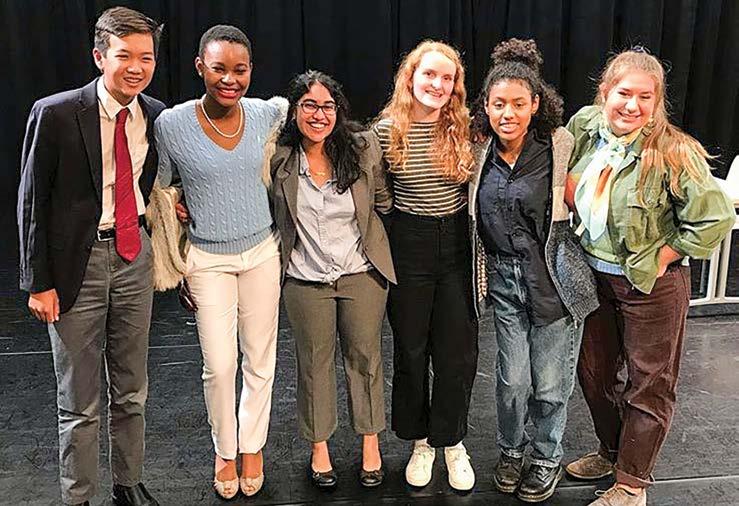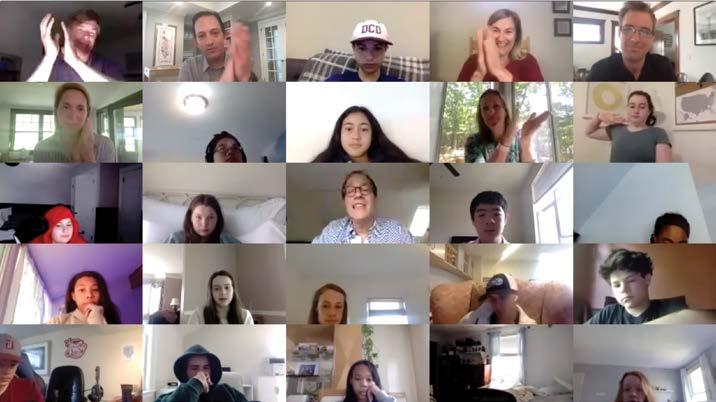
9 minute read
Head’s Report
by Allison D. Webster, Head of School
Advertisement
What elements are essential to provide a child with a meaningful, multi-dimensional, and robust education, one that creates a joyful daily life and lays a foundation for work and relationships in the future, an education that flexes and adapts as children grow? I’ve spent twenty-five years thinking about this question. Back in February, before the pandemic disrupted our lives, I would have felt fairly confident that my answers were complete; I see now, as the newly minted head of a virtual school, that my response needs adjusting.
My previous response to the question would have included explanations about a developmental understanding of students, a diverse cohort of peers, energized and autonomous teachers with a shared purpose, connected families as partners, facilities that support programs, a shared mission and pedagogy, anti-bias curriculum, explicit values, and key traditions. In many ways, my response hasn’t changed: all of the above still very much holds true. Yet, the vantage point of a pandemic has added clarity to my vision and brought into an even sharper focus the key elements of an excellent education. It also helped me spot what features held inadequate emphasis on my previous understanding.
The process of moving school online forced all of us at DCD to consider, again and again, what is essential that we are trying to create and preserve. What matters most about the content we are teaching students? What aspects of our relationships with students do the most to help understand themselves, feel motivated, and see themselves reflected in the world? How do families support and amplify our work with students? And how do peers—perhaps the most important part of school from a student perspective—play a role in supporting learning?
Our task was not a matter of merely moving old content to new platforms. Our task was to re-envision and rearticulate why we are doing what we are doing, and find how to translate these goals to a new platform best.
So what is even more apparent now, held up in starker relief?
The intricacy and interconnectivity of our school as a whole system and the many elements that contribute to the whole. As much as it appears that we have individual students and individual teachers (and even individual heads of school), the truth is that we function as a collective. The myth of our separateness is made clear in this time of separation; we provide a great education to the individual child because these individual units exist only in the context of an interconnected whole.
Understanding school as a system in this time makes me think of early forest researchers who discovered that the forests were far more complex than initially understood. The visible system of separate trees, soil, animals, and water had more nuance than they could have imagined. How so? Fungal networks under the soil serve as a type of internet for tree communication. Separate trees signal to each other from miles away, warning of danger or protecting each other by exchanging carbon and nutrients. All of this is invisible when looking at a forest. Trees that appear separate could be like a group of Aspens, all part of the same root system, and, in fact, one organism. Even logs on the forest floor play a vital role in making the system as a whole thrive—every piece of the system matters. Every element plays a role. The intricacy, interconnectivity, subtlety, and nuance of a forest system have a depth and beauty beyond what we once understood, and the same is true of our school.
So what does this new vantage point show us about each element of our DCD “forest,” and how can this new learning help us be a stronger school in the future? By keeping our focus on a few key areas, ones that have always distinguished DCD as a school and community, we can help our DCD grow and thrive. What is essential to remember?
We’re not just a collection of trees:
Just as a forest is not just a collection of trees, school is not just a collection of students. Much has been written in this time about the way the pandemic will shift us to a greater focus on the individual and more individualized forms of education. This analysis misses the point. Of course, we need to meet the needs of individual students, and some of the digital resources we are utilizing will help us better achieve this goal. This is good news for student learning and autonomy.
But the key takeaway from this moment is that each tree—or student—only thrives when it is part of an intricate system, and the focus on the system as a whole is vital to the strength of the individual. Schools like DCD that fuel a connection to the whole, help students look outward and appreciate that other people matter, and help students understand the way the pieces of our world and history fit together to explain the present, will be just like the most resilient forest systems. Our “trees” will grow individually because
we work together and see the world around us as a collective.
The thousands of millisecond moments that are missing from our current school day—the nearly imperceptible shifts in movement, facial expression, and reaction from peers and teachers—is a force that typically helps students to move like one organism. Left on their own, students struggle to see themselves and their own learning as clearly without having it consistently reflected back to them in a larger system. We are social beings, and we need to be in a context to learn well. Whether we return to brick-and-mortar school in the fall or continue some weeks of distance learning, we must continue to find ways to keep learning social, to keep students connected to the energy, belonging, and feedback they experience when they are part of a whole.
We need soil and sunshine:
Soil and sunshine, the key sources for creating nutrients for the whole system, must be in place for the system to flourish. Our teachers are the soil and sunlight of our system, creating nutrients for students with all of their imagination, creativity, determination, and skill. Great teachers are the key to building a great education for kids, and the current crisis has brought this truth into even starker relief.
The shift to distance learning has fallen on the shoulders of DCD’s teachers, and they have borne this responsibility with fortitude and imagination (right along with our families who
have supported the endeavor at home). Continuing to develop our systems to attract, hire, and retain the best teachers—like our current cohort who demonstrate adaptability and creativity beyond measure—is the key to educating students well and consistent with our “whole child” philosophy of nourishing the social/emotional as well as academic growth of children. Nothing supports this type of growth more effectively than educators who themselves are curious, lifelong learners and who can model those traits as well as teach them.
We must tend to the invisible systems:
Just as the health of trees is being shaped by systems of fungal pathways under the soil—a system that is invisible when looking at the trees—there are invisible systems at work shaping the health of our students and our school. The culture of our school is an invisible force that influences whether or not we will thrive. Cultivating the mindsets and behaviors that foster equity in our school, keep us aligned and connected, and make us resilient, is key to the health of every organism in our school ecosystem. We’ve felt the absence of some of the ways we build culture, like moments over coffee, or a hello at carpool; finding ways to deliberately cultivate our culture as a school, even if we are not on campus, is critical to our success as an institution. We’ve taken some steps during our distance learning to reinforce our interconnectivity, such as parent association-hosted remote coffees,
Zoom assemblies, our first-ever Hawk Day, and fun contests (who doesn’t like a good pie in the face?!), and will need to build on this foundation to continue nourishing our culture if we are faced with additional periods off-campus.
Nothing is extraneous in a connected system; every piece matters:
Every moment of the school day plays a role in a child’s education: the serendipitous walk down the hall with a student from another grade; the moment at recess that mixes new peers for a game; the bulletin board that sparks a new interest; the smell of a favorite food cooking that offers comfort; the physical feeling of being in a room with laughter and the reverberation in a room full of drummers. Nothing is superfluous, and it all adds up to a student’s experience.
How do we create richness and serendipity using the platforms and systems that are available to us? Many schools have prioritized simplifying the experience of learning, reverting to math and reading skill-development in a way that suggests this alone will suffice. But a child’s education needs to be so much more than simple skill acquisition, and each piece of the school day they experience, in all of its variety and richness, contributes to this whole. While, of course, we need to continue a child’s skill development, we also need to hang on to these broader goals, so we don’t devolve education into the imparting of a few narrow skills. That’s why we’ve strived to create as many opportunities as possible to enrich our students’ distance learning experience— from including arts and athletics in our remote curriculum to hosting 8th grade-kindergarten online “buddy” visits, to holding the annual DCD Fair with a combination of at-home and online celebrations.
If you imagine an individual leaf, with all of its color, shape, and texture, I’m sure you are moved by the beauty of such a perfect singular creation. Now imagine an entire tree filled with such leaves, each one as beautiful and intricate as the one you envisioned. Go on to picture that one tree’s worth of leaves multiplied over a forest of trees. Finally, see that forest as a connected system, each piece critical to the success of the whole.
Such is the awe-inspiring beauty of our school. I can see each face of our DCD students, and know the unique background, experiences, thoughts, and passions that make each child special. But when you imagine them, like you imagined the leaves and trees, each unit a small piece of a whole and connected system of children and adults, the awe-inspiring beauty of our school—and the power of it as a whole—comes into clearer focus. In this time of social distancing and separation, remembering the myth of our separateness and the power of our system as a collective will help us move forward to meet the needs of all of our children, together.

FEATURE Health Wellness and










